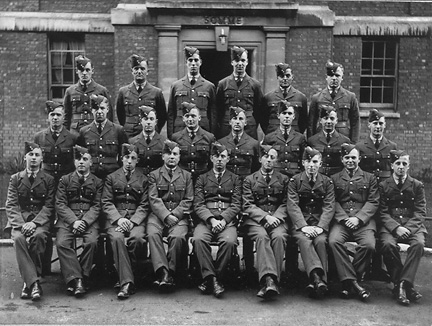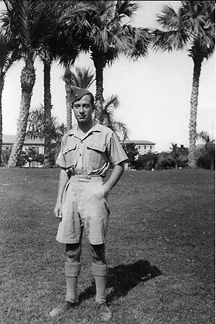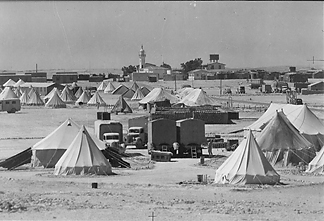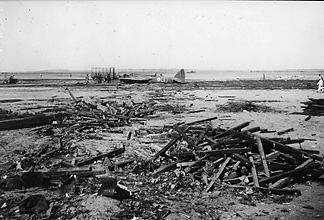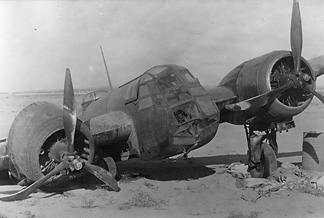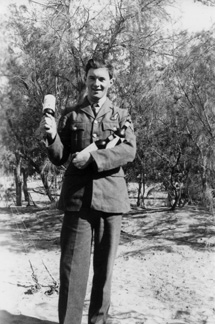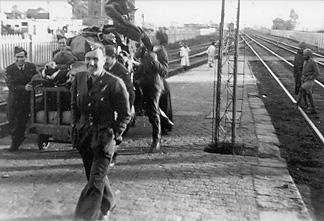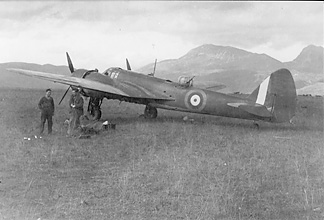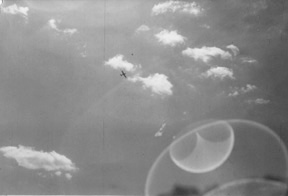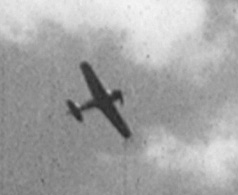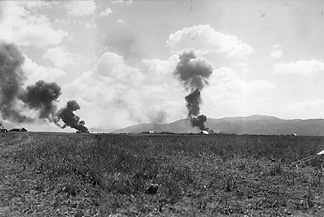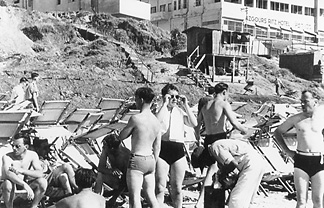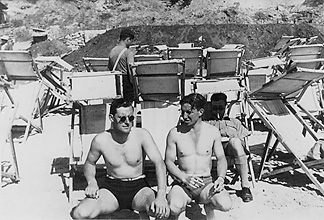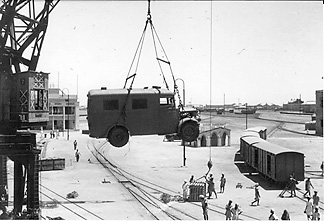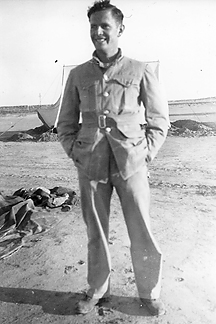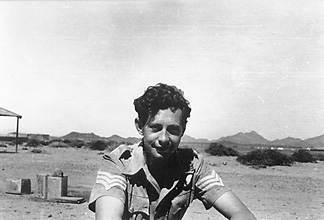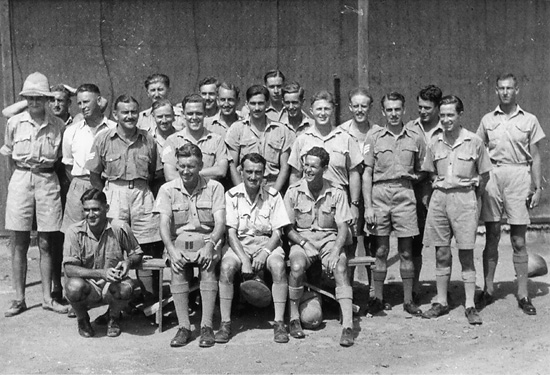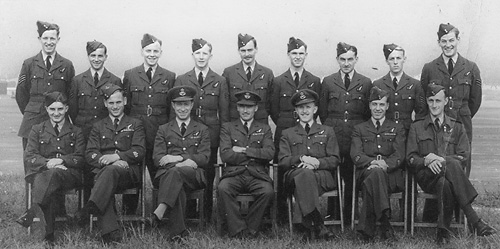 |
 |
||||||||||||||||||||||||||
|
Sgt JG Sharratt RAF 544278; S/Ldr RAF 49550 1917—2007 John Gerard Sharratt was born in February 1917. At the age of 11 he began attending St Elizabeth’s Central School in Liverpool, leaving at age 15. The Great Depression bit hard and by 1932 times were at their hardest in the Midlands. Perhaps that spurred him on to further effort, for he took on a series of correspondence courses from 1933 to 1935. By then there were stirrings of recovery in the United Kingdom. By 1937, the League of Nations was struggling to deal with rising world tension. The year before, the European powers had begun re-arming and overseas, Ethiopia had fallen to Italian forces. The April 1937 bombing of Guernica in the Spanish Civil War caused unease in Europe, the inevitable final collapse of the International Disarmament Conference following that May. In July, Japan’s war in China began in earnest, followed after months of battle by the fall of Shanghai and the massacre at Nanking. The RAF
In the hands of a dour Flight Sergeant, the recruits of 19 Squadron, (ie a training formation) RAF Uxbridge, November 1937. AC2 JG Sharratt middle row, third from the left. From December 1937 it was off to Cranwell and the Wireless Operators Course. Qualified as Ground Wireless Operator, he was posted to RAF Hemswell in September 1938 as the Munich Crisis was about to break. Still, progress in the peacetime RAF could be slow for a young airman, even in a skilled trade. To the Middle East... About this time, following the lead of 30 Squadron (whose new aircraft had entered service in early 1938) most of the remaining RAF Middle East bomber units were about to convert to the Bristol Blenheim I. 211 Squadron... and the Desert
Another wonderful addition to the 211 Squadron Blenheim story. JG joined ‘B’ Flight of the Squadron in the last months of peace. At Daba, his camera caught four aircraft of the Flight in close order still with their immediate pre-war codes: LJ-R leading, LJ-P to the left. The third aircraft carries no squadron code at all, while only LJ is visible on the fourth. The photograph appears to be on orthochrome film, the aircraft in European paint, and both R and P seem to have the white (or very light grey) neat 3-D letter-form also seen in the photos of another early arrival, M Sainsbury, and of CFR Clark (my father). For decades, the use of the LJ code by the Squadron was regarded as “unrecorded”. War, it is said, is made up of long periods of boredom and short bursts of intense excitement. As aircrew under training in an operational Squadron, Sharratt was to find the pace of events slow and flying hours hard to come by. By year’s end, he had just 10:25hrs in the flying log. Then came two months without so much as a circuit. With war far away, endless days of sun and sand may have started to drag somewhat. At last the pace of flying and training quickened. During February 1940 the hours in the turret clocked up pretty steadily. By the end of May he had achieved 61:25 flying hours in the gunner’s turret under the tutelage of Pike, Collier and others whose names were to become lustrous with 211 Squadron: Burnett, Delaney, Ritchie, and Doudney; Gordon-Finlayson signing the log as F/Lt and OC in the absence of Judge. On operations In early July and still not formally qualified, came a second but aborted sortie to Tobruk, turning back with engine trouble. On a brief detachment back to the Pilots Reserve and Reinforcement Pool at Ismailia two weeks later, JG got what seems to have been his final check: a 45 min AG training flight in Blenheim I L8445 with one P/O Crocket. The PRRP had a handful of Mark Is for aircrew training, as well as a motley collection of more antique machines. Three days later, the Flying Log recorded his formal endorsement: “JG Sharratt has qualified as Wireless Operator/Air Gunner”. Promotion to Sergeant was to follow, with effect from 29 July—aloft in L6660 with Pat Burnett, he was busy carrying out a local aerial photography sortie. The paper work may have taken some time to catch up: the Squadron Operations Record Book continued to record him as LAC Sharratt for two more months.
Plainly in the Middle East, a Sergeant’s stripes on his right sleeve but no other visible insignia. The buildings in the background are suggestive of RAF Heliopolis, favoured by the Greyhounds on leave before the war and during. JG was made up to Sergeant with effect from the end of July 1940, this shot may be from about that time, or perhaps as late as December 1940. So by August 1940, “JG the AG” was ready for whatever might come his way. Other accounts (Dundas and Gordon-Finlayson for example) show the intense flying that was now their lot. In August alone, Sharratt added 21:50hrs to his flying time and four raids over Derna or Tobruk to his tally, one of them against the infamous floating crane in Tobruk harbour. It took the Blenheim Squadrons a considerable number of strikes to sink this bit of kit, but when Tobruk was taken the first thing the Navy did was refloat it. There was no let up in September, and by the end of the month Sgt Sharratt had well over 100hrs in the log, including 12 on night operations. Early October was busy too but then, with a year of desert service and 14 completed operations to his credit, came a brief interval of rest, posted with Sgt Watkins back to Ismailia again and what had now become the Training Unit and Reserve Pool, first tour complete. A brief respite Then it was off back to Egypt, courtesy of 230 Squadron’s Sunderland men: of all people, with F/Lt Lywood in Sunderland N9029 to Crete and then on to Alexandria in L5804 with P/O McCall (Lywood was later to evacuate parties of 211 Squadron men from Greece, including George Checketts, my late father, and Bill Stack). Then across the hardstanding to 70 OTU and another Blenheim job with another familiar face, Pat Burnett, now F/Lt, in the cockpit while they searched for a missing aircraft over the Nile/Gulf of Suez area. With the Greyhounds in Greece On 10 February the Squadron moved forward to Paramythia, in the mountainous north, just short of the Albanian border. Over the course of the month, JG accumulated 24:35hrs in the air, all of it as WOp/AG with Hooper and Geary. Together they notched up 10 raids in 16 days. The pace never slackened. So at Paramythia on Easter Sunday (13 April 1941) they were busy, turning back from an early morning sortie to Lake Ochrida with a dud engine on L8466, then a successful mid-afternoon photo recce to Valona in L1536 and then, the valiant 18 now missing, a final sombre dusk flight to Menidi. But with L1536 now misbehaving too, they headed instead for Elevsis, forced-landing there on one engine. When it came time to leave Greece, Hooper, Geary and Sharratt had completed 24 sorties together. Sharratt’s tally in all was then 39, with 227hrs in the log. Lywood was on hand once more to pilot them to safety, leaving Scaramanga on 20 April in Sunderland N9029 for Crete, and the next day, on to Alexandria. Palestine The Squadron briefly had some Mark IV Blenheims on hand and in this comparative luxury, Hooper, Geary and Sharrat carried out 4 more sorties. One of them, V5946, he (perhaps ruefully) noted as a Blenheim Mark VIII. The aircraft was in fact a quite new Rootes-built Mark IV of 1941 date, otherwise only recorded as of 11 Squadron, with whom 211 were closely associated in the final days at Athens and in Palestine. Indeed, JG’s final two sorties of the war, still with Hooper, he recorded in early June as with 11 Squadron. However, his Log Book that month was still signed by Ken Dundas DFC and W/Cdr Blomfield, both in their 211 Squadron capacity. At the end of June 1941, in just over 12 months active service Sgt John Gerard Sharratt has accrued a total of 247hrs flying time and 45 sorties in two operational stints of nine months in all with 211 Squadron, 30 of them in just four months and with the same crew: Hooper, Geary, Sharratt. He had in fact completed a second tour of 35 sorties. Wadi Gazouza, 72 OTU and after They withdrew by air, sea and rail to Wadi Gazouza, far to the South to set up and eventually form the nucleus of a new Operational Training Unit, No 72. Gazouza was an isolated place in the Red Sea Hills of Sudan, the only amenity being the railway back through Summit and Gebeit to Port Sudan. A rest hard-earned, though it was to be no great picnic in the sand and scrub. On 18 October, veteran of Palestine, the Desert and Greece Sgt JJ “Paddy” Kavanagh DFM died, of natural causes. They laid him to rest at Gebeit. JG had advanced to Flight Sergeant in June and flew occasionally as part of his radio instructor duties as senior NCO Signals. Part of the signals task would also have been radio watch and assistance for geographically embarrassed trainees. At year’s end, as Japan entered the war, the time came for 211 Squadron to resume operational status. With it came something of a wrench, a number of old hands remaining with the training unit (JG among them), others returning to operations (like Bill Baird) while yet others were posted elsewhere (like my father). The way of the Service. In April 1942, 72 OTU departed The Sudan for Nanyuki in Kenya taking Sharratt with them as Signals Instructor. There they grew into a quite large establishment. In June 1942, his efforts were rewarded: commissioned a Pilot Officer, by December he had advanced to Flying Officer. He remained with them, flying mainly in the Ansons that were well-suited for radio work, until 1943. As the need for aircrew changed, 72 OTU’s task was coming to an end. In March 1943, as the unit disbanded, his air gunner’s log showed 310:35hrs flying time, 54:35hrs of that with 72 OTU. The parting gift of his Senior Signals Officer was that rarest of Service accolades, a rating of “Exceptional” in his proficiency as Wireless Operator and Gunner instructing in the turret and signals. Home again It seems clear that JG enjoyed his role as RAF instructor. Moving steadily around the training establishments of the RAF at home, 27 OTU, 80 OTU and 82 OTU all saw him instructing on signals. Soon his efforts were recognised again, with a Mention in despatches in January 1944 and promotion to Flight Lieutenant that June. The post-war RAF and a change in tack Now aged 30, the flying, gunnery and signalling couldn’t last forever, but JG was ready. Applying himself to study once more, he transferred to the Secretarial Branch in January 1949, remaking himself into a useful staff and accounts officer. Over the following years, his skill and application carried him onward, with postings that included Senior Accounts Officer at RAF Cranwell and Command Cashier at HQ RAF Germany. Heady stuff, though from turret to desk. In 1952, aged 35, JG passed another milestone of service, with promotion to Squadron Leader in a much reduced peacetime RAF. It was only in 1972, after 35 years service in all, that Squadron Leader JG Sharratt 49550 retired from the Royal Air Force. Afternoon light Thus this page came together in time for the Australia Day 2007 site edition, thanks to Pat’s kind interest and generosity, in lending a great deal of splendid material including her husband’s log book, his own detailed service notes, and a large selection of the most wonderful images. Photographs of an Air Gunner
A beautiful print of another of the popular shots among the 211s. They may not have liked Daaba much, but they liked this photograph. The mosque is still there today, at the rear of the Station. The railyards are larger now and the village has become a township, with orchards and paved streets.
A different view of Pete Collier’s close encounter with the railway sleepers. Photographs of L1486’s misadventure were held by a number of Squadron lads: Cooper, Grierson (with a fuller account), Hoyes, Sainsbury and Wingrove..
The crash scene of L6660 after a little recovery work has begun, also photographed by Geoff Grierson.
JG and Wingrove were made Sergeant WOp/AG at about the same time, by September 1940. Wingrove had been with 211 Squadron even longer and with at least 18 operations to his credit was repatriated to the UK in October as the Squadron was readying for the move to Greece. This image, named by JG, confirmed my interpretation of Wingrove’s identity from his own photograph collection. A poignant shot: Ralph Wingrove, though an instructor and not on operations in the UK, did not survive the war.
Unknown P/O observer, foreground. Sgt JG Sharratt steering the baggage trolley, left.
Sharratt centre. The other two may be Steve Geary, left and possibly Hooper obscured to the rear, although he looks remarkably like Bill Stack! The Mark I apparently has its bomb-bay doors removed and is in European paint on the upper surfaces, possibly sky blue beneath, without Squadron markings and with serial no obscured. The scene is certainly on the ground at Paramythia, looking to the North. The village lies out of frame, on a ridge to the right. A RHAF PZL-24 parasol monoplane fighter stands in the background beyond the rear fuselage, and in the right background stands a tent of the Squadron encampment.
A beautiful composite. Nothing stopped these men from taking photographs.
There are so few photos of my father with 211 Squadron, my jaw dropped when I saw this one for the first time. JG Sharratt left, in uniform. Gerry Martin to the left rear, Peter Dennis, Bill Stack in uniform to the rear, my father, Sgt CFR “Nobby” Clark, on the right.
Unnamed group of Sergeant airmen. My Dad, back to camera, centre. On the popular beach front at Tel Aviv you could still hire natty shaded deckchairs like these in the 1970s. Although Azgours Ritz Hotel is no more, in 1941 it was an upmarket officers-only hotel at 111 Hayarkon, right on the beach that the Israelis have long called Gordon-Frischmann (that is, between those two streets of old Tel Aviv). The site at the corner of Frischmann and Hayarkon is now the modern head office of the Dan Hotel chain.
Peter Dennis, left, Nobby Clark, right, Bill Stack having a smoke in the shade. One small but notable point about these undress shots: all but one of the men in swimmers have taken off their tags, too.
The best version of this photograph, fully discussed on Bill Baird’s page. Bill is seventh from the right, rear, JG is second from the right, rear, hands behind. This must be the last shot of Paddy Kavanagh DFM, who is second from the left, seated with hat, front. A happy shot of seasoned 211 NCOs and fresh RAAF men.
JG third from the left. Another happy group shot, and a regular RAF officer happy in his peacetime work at No. 2 Air Navigation School. JG Sharratt 1917—2007 Sources AIF News 16 Nov 1940.
www.211squadron.org © D Clark & others 1998—2025 |
||||||||||||||||||||||||||
